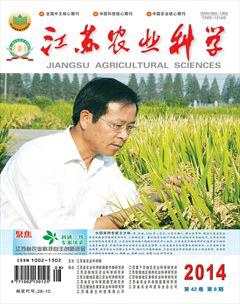GC—MS分析夏黑葡萄中挥发性香气成分
张海宁+王亚超+马辉+袁小单+马永昆
摘要:通过固相微萃取-气质联用技术(SPME-GC-MS)定量分析优质夏黑葡萄果皮、果肉中挥发性物质成分及含量,结果表明,夏黑葡萄果皮中挥发性物质含量多于果肉中挥发性物质含量,果皮中共检出48种挥发性成分,其中醇类、烯类物质是主要的香气成分,果肉中共检出41种挥发性成分,其中醛类、酚类物质是主要香气成分。夏黑葡萄的特征香气为大马酮、芳樟醇、D-柠檬烯、香叶醇、橙花醇。
关键词:夏黑葡萄;挥发性物质;固相微萃取(SPME);气质联用(GC-MS)
中图分类号:O657.63;S663.101 文献标志码:A
文章编号:1002-1302(2014)08-0294-04
夏黑葡萄(summer black)原产于日本,属欧美葡萄杂交种,是三倍体无核品种,具有抗病、丰产、早熟、优质、耐储运等优点,在我国种植面积很大[1]。葡萄的香气成分是判断葡萄品质的重要指标之一,主要包括萜烯类、C6醇类、C6醛类、芳香醇类、吡嗪类等化合物,葡萄中这些挥发性香气成分是葡萄酒典型性风味的主要来源[2]。由于葡萄中挥发性香气成分含量较低,因此要选择合适的分析方法。固相微萃取(SPME)具有分离时间短、不需要有机溶剂、能提高检测限等优点,气质联用技术(GC-MS)则被广泛应用于挥发性成分的定性、定量分析[3-6]。本试验应用固相微萃取(SPME)、气质联用法(GC-MS)对江苏省镇江地区优质夏黑葡萄的果皮、果肉中挥发性成分进行检测,分析夏黑葡萄中主要挥发性香气成分,旨在为夏黑葡萄深加工提供指导。
1 材料与方法
1.1 材料
夏黑葡萄采自江苏省句容市白兔镇某合作社。葡萄充分成熟、大小均一、无腐烂变质、pH值2.4、可溶性固形物含量为16.5%、总糖含量159.8 g/L、总酸(以酒石酸计)含量7.0 g/L。
1.2 仪器与试剂
壬醇(色谱纯)购自美国Sigma公司,氯化钠(分析纯)购自上海化学试剂有限公司,PC-420型电热磁力搅拌器(美国Corning公司),固相微萃取装置(美国Supelco公司),萃取纤维头100 μm DVB/CAR/PDMS(美国Supelco公司),HP6890/5973型气相色谱-质谱-嗅闻联用仪(美国Agilent公司),TGL-20M高速台式冷冻离心机(湘仪离心机仪器有限公司)。
1.3 方法
1.3.1 葡萄果皮香气萃取方法[7]
采摘新鲜葡萄,人工去皮,用去离子水轻轻冲洗果皮上果肉、果汁,用吸水纸吸干水分,称取2 g葡萄皮,装入500 mL三角瓶中,加入10 mL模拟葡萄汁(用酒石酸调整去离子水pH值为2.4),40 ℃水浴浸提30 min,取8 mL模拟葡萄汁置于15 mL顶空瓶中,加入 1.0 g 分析纯氯化钠,以4 μL壬醇作为内标,将顶空瓶置于电磁搅拌器上,40 ℃预热10 min,磁力搅拌速度为800 r/min,萃取30 min后用于GC-MS检测。
1.3.2 葡萄果肉香气萃取方法[7]
将新鲜葡萄去果皮,破碎后取自流汁,5 000 r/min离心10 min,取上清液待用。取 5 mL 葡萄汁加入15 mL顶空瓶中,添加1.0 g分析纯氯化钠,4 μL壬醇作为内标,将顶空瓶置于电磁搅拌器上,40 ℃预热10 min,磁力搅拌速度为800 r/min,萃取30 min后用于GC-MS检测。
1.3.3 GC-MS参数
GC条件:色谱柱为DB-WAX柱(60 m×0.25 mm×0.25 μm),进样口温度250 ℃,载气为高纯氦气,流量为1.0 mL/min,不分流。程序升温:初始温度 50 ℃ 保持3 min,然后以6 ℃/min的速度升至170 ℃,再以 4 ℃/min 的速度升至230 ℃,保持2 min。质谱条件:5973型四极杆质谱仪,接口温度250 ℃,电子轰击(EI)离子源,电子能量为70 eV,离子源温度为230 ℃,四极杆温度为150 ℃,电子倍增器电压为1 353 V,质量扫描范围33~450 amu。
1.3.4 挥发性化合物定性与定量分析方法
定性方法:将未知物图谱与NIST98谱库进行比对并初步鉴定,再结合保留时间、参考文献、质谱离子图进行定性分析[8]。定量方法:采用内标法相对定量(假定校正因子为1),将内标物的峰面积与每个组分的峰面积进行比对,计算挥发性香气物质相对于内标的含量,计算公式如下[9]:
3 结论
本研究表明,夏黑葡萄果皮中挥发性物质含量多于果肉中挥发性物质含量,果皮中共检出48种挥发性成分,其中醇类、烯类物质是主要的香气成分,果肉中共检出41种挥发性成分,其中醛类、酚类物质是主要香气成分。夏黑葡萄的特征香气为大马酮、芳樟醇、D-柠檬烯、香叶醇、橙花醇。
参考文献:
[1]任俊鹏,郑 焕,江 楠,等. 脱落酸浸果对夏黑葡萄果实着色及品质的影响[J]. 江苏农业科学,2012,40(11):156-158.
[2]薛 洁. 葡萄品种的香气[J]. 中外葡萄与葡萄酒,2003(6):55-59.
[3]Kataoka H,Lord H L,Pawliszyn J. Applications of solid-phase microextraction in food analysis[J]. Journal of Chromatography A,2000,880(1/2):35-62.
[4]Curran A M,Rabin S I,Prada P A,et al. Comparison of the volatile organic compounds present in human odor using SPME-GC/MS[J]. Journal of Chemical Ecology,2005,31(7):1607-1619.endprint
[5]Rega B,Fournier N,Guichard E. Solid phase microextraction(SPME)of orange juice flavor:odor representativeness by direct gas chromatography olfactometry(D-GC-O)[J]. Journal of Agricultural and Food Chemistry,2003,51(24):7092-7099.
[6]Jordán M J,Margaría C A,Shaw P E,et al. Aroma active components in aqueous kiwi fruit essence and kiwi fruit puree by GC-MS and multidimensional GC/GC-O[J]. Journal of Agricultural and Food Chemistry,2002,50(19):5386-5390.
[7]范文来,徐 岩,李记明,等. 应用HS-SPME技术分析葡萄果皮与果肉挥发性香气物质[J]. 食品与发酵工业,2011,37(12):113-118.
[8]袁小单,严 蕊,马永昆,等. 基于SPME-GC-MS的超高压镇江香醋香气变化分析[J]. 食品科技,2012,37(11):263-269.
[9]张 义. 龙眼汁香气物质及其在加工和贮藏过程中的变化规律[D]. 武汉:华中农业大学,2010.
[10]Selli S,Canbas A,Cabaroglu T,et al. Aroma components of cv. Muscat of Bornova wines and influence of skin contact treatment[J]. Food Chemistry,2006,94(3):319-326.
[11]Palomo E S,Pérez-Coello M S,Díaz-Maroto M C,et al. Contribution of free and glycosidically-bound volatile compounds to the aroma of Muscat “a petit grains” wines and effect of skin contact[J]. Food Chemistry,2006,95(2):279-289.
[12]马永昆,刘晓庚. 食品化学[M]. 南京:东南大学出版社,2007.
[13]Buttery R G,Teranishi R,Ling L C,et al. Quantitative and sensory studies on tomato paste volatiles[J]. Journal of Agricultural and Food Chemistry,1990,38(1):336-340.
[14]Ahmed E M,Dennison R A,Dougherty R H,et al. Flavor and odor thresholds in water of selected orange juice components[J]. Journal of Agricultural and Food Chemistry,1978,26(1):187-191.
[15]Guth H. Quantitation and sensory studies of character impact odorants of different white wine varieties[J]. Journal of Agricultural and Food Chemistry,1997,45(8):3027-3032.
[16]Zalacain A,Marín J,Alonso G L,et al. Analysis of wine primary aroma compounds by stir bar sorptive extraction[J]. Talanta,2007,71(4):1610-1615.endprint
[5]Rega B,Fournier N,Guichard E. Solid phase microextraction(SPME)of orange juice flavor:odor representativeness by direct gas chromatography olfactometry(D-GC-O)[J]. Journal of Agricultural and Food Chemistry,2003,51(24):7092-7099.
[6]Jordán M J,Margaría C A,Shaw P E,et al. Aroma active components in aqueous kiwi fruit essence and kiwi fruit puree by GC-MS and multidimensional GC/GC-O[J]. Journal of Agricultural and Food Chemistry,2002,50(19):5386-5390.
[7]范文来,徐 岩,李记明,等. 应用HS-SPME技术分析葡萄果皮与果肉挥发性香气物质[J]. 食品与发酵工业,2011,37(12):113-118.
[8]袁小单,严 蕊,马永昆,等. 基于SPME-GC-MS的超高压镇江香醋香气变化分析[J]. 食品科技,2012,37(11):263-269.
[9]张 义. 龙眼汁香气物质及其在加工和贮藏过程中的变化规律[D]. 武汉:华中农业大学,2010.
[10]Selli S,Canbas A,Cabaroglu T,et al. Aroma components of cv. Muscat of Bornova wines and influence of skin contact treatment[J]. Food Chemistry,2006,94(3):319-326.
[11]Palomo E S,Pérez-Coello M S,Díaz-Maroto M C,et al. Contribution of free and glycosidically-bound volatile compounds to the aroma of Muscat “a petit grains” wines and effect of skin contact[J]. Food Chemistry,2006,95(2):279-289.
[12]马永昆,刘晓庚. 食品化学[M]. 南京:东南大学出版社,2007.
[13]Buttery R G,Teranishi R,Ling L C,et al. Quantitative and sensory studies on tomato paste volatiles[J]. Journal of Agricultural and Food Chemistry,1990,38(1):336-340.
[14]Ahmed E M,Dennison R A,Dougherty R H,et al. Flavor and odor thresholds in water of selected orange juice components[J]. Journal of Agricultural and Food Chemistry,1978,26(1):187-191.
[15]Guth H. Quantitation and sensory studies of character impact odorants of different white wine varieties[J]. Journal of Agricultural and Food Chemistry,1997,45(8):3027-3032.
[16]Zalacain A,Marín J,Alonso G L,et al. Analysis of wine primary aroma compounds by stir bar sorptive extraction[J]. Talanta,2007,71(4):1610-1615.endprint
[5]Rega B,Fournier N,Guichard E. Solid phase microextraction(SPME)of orange juice flavor:odor representativeness by direct gas chromatography olfactometry(D-GC-O)[J]. Journal of Agricultural and Food Chemistry,2003,51(24):7092-7099.
[6]Jordán M J,Margaría C A,Shaw P E,et al. Aroma active components in aqueous kiwi fruit essence and kiwi fruit puree by GC-MS and multidimensional GC/GC-O[J]. Journal of Agricultural and Food Chemistry,2002,50(19):5386-5390.
[7]范文来,徐 岩,李记明,等. 应用HS-SPME技术分析葡萄果皮与果肉挥发性香气物质[J]. 食品与发酵工业,2011,37(12):113-118.
[8]袁小单,严 蕊,马永昆,等. 基于SPME-GC-MS的超高压镇江香醋香气变化分析[J]. 食品科技,2012,37(11):263-269.
[9]张 义. 龙眼汁香气物质及其在加工和贮藏过程中的变化规律[D]. 武汉:华中农业大学,2010.
[10]Selli S,Canbas A,Cabaroglu T,et al. Aroma components of cv. Muscat of Bornova wines and influence of skin contact treatment[J]. Food Chemistry,2006,94(3):319-326.
[11]Palomo E S,Pérez-Coello M S,Díaz-Maroto M C,et al. Contribution of free and glycosidically-bound volatile compounds to the aroma of Muscat “a petit grains” wines and effect of skin contact[J]. Food Chemistry,2006,95(2):279-289.
[12]马永昆,刘晓庚. 食品化学[M]. 南京:东南大学出版社,2007.
[13]Buttery R G,Teranishi R,Ling L C,et al. Quantitative and sensory studies on tomato paste volatiles[J]. Journal of Agricultural and Food Chemistry,1990,38(1):336-340.
[14]Ahmed E M,Dennison R A,Dougherty R H,et al. Flavor and odor thresholds in water of selected orange juice components[J]. Journal of Agricultural and Food Chemistry,1978,26(1):187-191.
[15]Guth H. Quantitation and sensory studies of character impact odorants of different white wine varieties[J]. Journal of Agricultural and Food Chemistry,1997,45(8):3027-3032.
[16]Zalacain A,Marín J,Alonso G L,et al. Analysis of wine primary aroma compounds by stir bar sorptive extraction[J]. Talanta,2007,71(4):1610-1615.endprint

